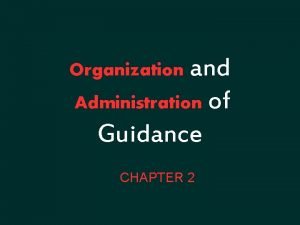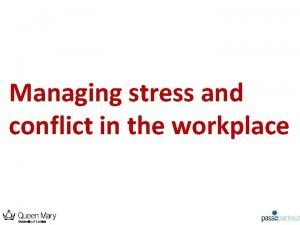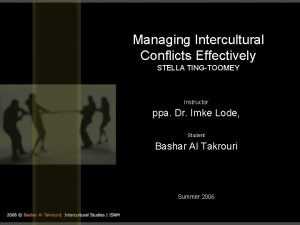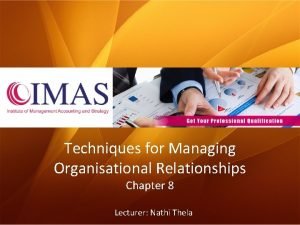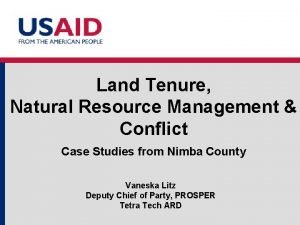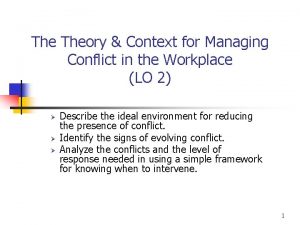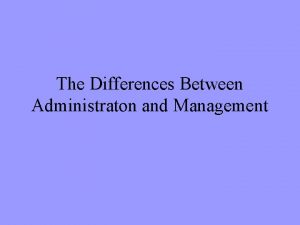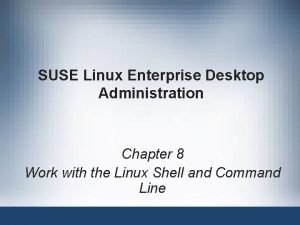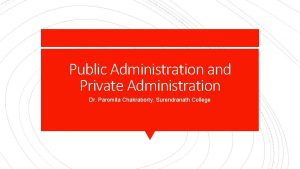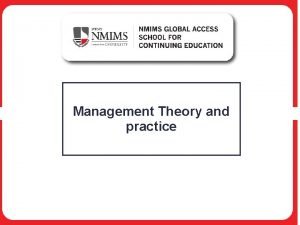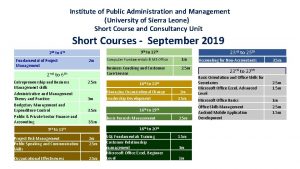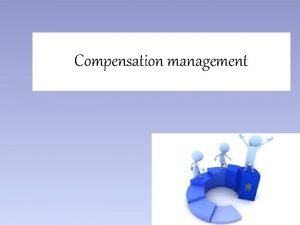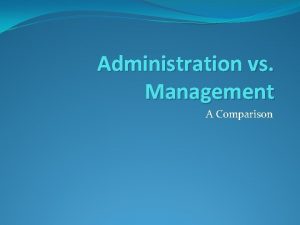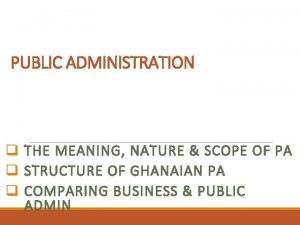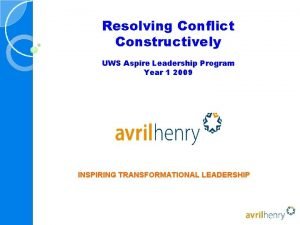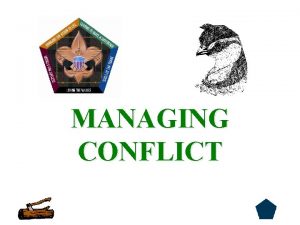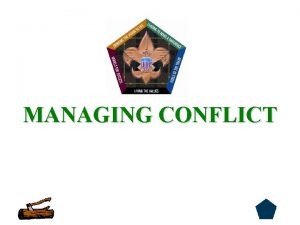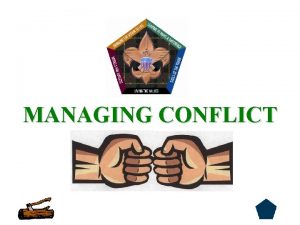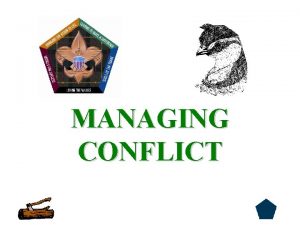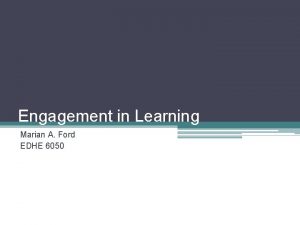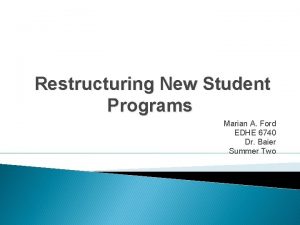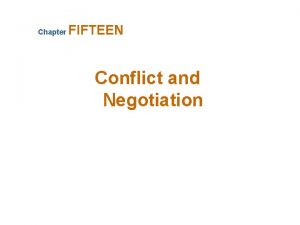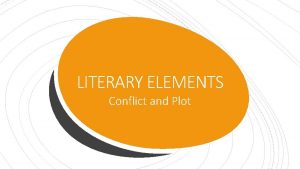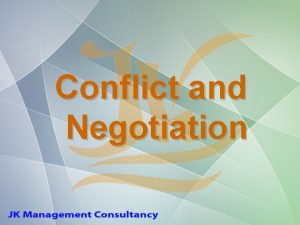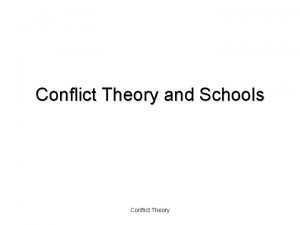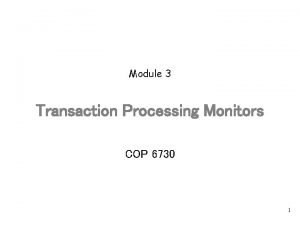Managing Conflict Constructively EDHE 6730 Organization and Administration




























- Slides: 28

Managing Conflict Constructively EDHE 6730 Organization and Administration of Student Development Services By Lisa S. Estrada-Hamby

Conflict on campus n Managing conflict is one of the most frequently called for skills in daily interactions on a college campus. n Many of us feel uncomfortable and unskilled in responding to conflict situations and experience the negative result of conflict.

Conflict Assumptions n One’s view of conflict is influenced in part by cultural values about conflict and interpersonal relationships. n Those whose values resemble mainstream America have learned the values of Western culture.

Western Culture n Culturally-biased assumptions includes that everyone has the same definitions of “good” and “bad, ” of “right” and “wrong. ” n Common view of human behavior is “more or less universal across social, cultural, economic, and political backgrounds. ”

Viewing Conflict n When we view conflict, we see the conflict from our worldview that may not include positive experiences. n Whatever the view may be, we do not recognize the existence of other worldviews of the same conflict.

Values on a Continuum n n n Competition Egalitarian Admission of Error Individualistic Youth-Oriented Emotional Responses Deadline Intensive Casual Behavior Authoritative Decisions Contractual Openness to Change n n n Collaboration Hierarchical Saving Face Collectivistic Respect for Age Controlled Responses Time Not an Issue Formal Behavior Consensus Implied Agreement Reluctance to Change

Knowledge about Conflict n Conflict may be defined as “a situation between two or more parties who see their perspectives as incompatible. ” n Power imbalances between parties to a conflict may significantly affect the range of approaches that might be used to address conflict.

Approach to Conflict n The range of approaches moves from conflict avoidance to direct action in the form of violence. n Includes: avoidance, informal discussion and problem-solving, negotiation, and mediation are characterized as involving private decisionmaking by the parties involved in the conflict, with low potential for coercion or win-lose tactics.

Range of Approaches n Based on mutual willingness to participate in addressing the conflict, depends on identifying mutually acceptable solutions and, in the case of mediation, results in a mutually agreed-upon approach to resolving or reducing the conflict.

Mediation n Defined as “the intervention into a dispute or negotiation by an acceptable, impartial, and neutral third party who has no authoritative decision-making power to assist disputing parties in voluntarily reaching their own mutually acceptable settlement of issues in dispute. ”

Mediator’s Role n Helping the parties communicate more clearly with one another n Identifying misunderstandings or misconceptions that seem to be impeding communication n Helping to sort out multiple issues related to the conflict and assisting the parties to agree on which issues need attention first n Offering ways to improve the parties’ skills in discussing solution, and n Helping to sort out perceived incompatibilities from actual differences

Attitudes Toward Conflict n Models of managing conflict seem to be built on an assumption that doing something is better than doing nothing at all n Or that collaboration is always better than compromise when it comes to managing conflict n Previous characterizations of approaches add an unrealistic and limiting attitude toward conflict management, namely that certain approaches are never as good as others.

Thomas and Kilmann (1974) n Begin with the assumptions that the situation shapes approaches to conflict, and that based on the situation all approaches have value. n Developed (CMI) the Conflict Mode Instrument

Conflict Mode Instrument (CMI) n. A self-report instrument used in workshops on conflict to help participants understand their typical approaches to interpersonal conflict n The resulting scores are displayed as a combination of two dimensions

CMI Two Dimensions n The extent to which the approach satisfies the individual’s needs or concerns related to the conflict, and n The extent to which the approach satisfies the other person’s needs or concerns

CMI Five Conflict Modes n Competing n Collaborating n Compromising – Power-oriented and focused on winning – Full acknowledgment of both the individual’s and the other’s needs or concerns and a focus on finding common ground within a conflict on which to base some mutually agreeable approach to the conflict – Characterized as a more expedient approach to conflict that partially responds to both parties. It usually involves giving up something in order to solve the problem, seeking a middle ground

CMI Five Conflict Modes con’t n Avoiding n Accommodating – Characterized as responding to neither the individual nor the other person. Might take the form of diplomatically sidestepping an issue, postponing an issue until a better time, or simply withdrawing from a threatening situation. – Characterized as responding entirely to the other’s needs or concerns while neglecting or ignoring one’s own. Might include obeying another’s order when one might prefer not to, or yielding to another’s opinion

Conflict Mode Instrument n Is then used to assess an individual’s tendency to rely too much on certain approaches or to avoid using other approaches n The message of the instrument and its interpretation is that all approaches have value, depending on the situation surrounding the conflict

Situation-Based Approach n Concept that a clear idea of the outcomes sought will help those involved in a conflict to select approaches that match these outcomes n The work of finding outcomes that the parties can agree on is often the most important action in managing conflict

Skills in Managing Conflict n Come from Counseling – Active listening – Clarifying statements made by others – Expressing empathy, – Building trust, and – Basic skills of problem solving

Skills Developed in Leadership Education Programs n Summarizing n Reframing comments to reduce negative perceptions of the ideas of others n Helping group members respond to issues and ideas and not to personality n Assuring that all have the opportunity to state their opinions and thoughts n Identifying power imbalances among group members that seem to be a potential detriment to clear communication, and n Being aware of nonverbal communication

Intercultural Communication Skills n Being aware of our own frame of reference as well as that of others n Identifying and checking with the other person assumptions and inferences made about that person’s perspective, and n Paying attention to the variety of meanings assigned by different cultures to nonverbal behaviors.

Pedersen’s (1994) Development of Skills n Accomplished effectively through modeling and demonstration n The use of videotaping to provide students with feedback about their skill level n Supervising students in the application and use of skills, and n Practicing the skills and behaviors in as many settings and different situations as possible

Summary n Establish the notion that conflict is inevitable, and that its lack of constructive management is both common and problematic n Learning to deal with conflict is one of the most important and difficult skills SA administrators can develop

Summary con’t n Graduate preparation programs and staff development programs need to provide frequent opportunities for practicing the skills of conflict management, add opportunities for discussing case studies involving conflict, and include more systematic study of knowledge about conflict as part of professional development

Summary con’t n Practitioner should address management of conflict as part of a campus culture change n Students need skills workshops on managing conflict n Peer educators can be a very effective means of delivering these workshops n Student leadership development programs should contain workshops and case studies about conflict n Students conduct skill-building among parties involved in conflict

Summary con’t n Senior SA officer must endorse and exemplify flexibility in approaches to conflict and serve as a spokesperson with other campus constituencies about the importance of developing conflict management skills n Employee grievance procedures should include skills-building in managing conflict n Staff evaluations should speak directly to an employee’s conflict management capabilities n Members of the campus community should know where to go on campus to find information, support, and education on matters related to conflict

Reference n Barr, M. J. , Desler, M. K. , and Associates. (2000). The handbook of student affairs administration. Jossey-Bass Publishers.
 Organization and administration of guidance
Organization and administration of guidance Conflict in psychology
Conflict in psychology Stress and conflict introduction
Stress and conflict introduction Stella ting toomey
Stella ting toomey Mainwaring conflict management
Mainwaring conflict management Ways of managing conflict in the community
Ways of managing conflict in the community Managing conflict theory
Managing conflict theory Managing holistic marketing organization
Managing holistic marketing organization Internal conflict vs external conflict
Internal conflict vs external conflict What is conflict and conflict resolution?
What is conflict and conflict resolution? Internal conflict definition
Internal conflict definition Compare and contrast organization
Compare and contrast organization Process organization in computer organization
Process organization in computer organization Who has propounded differential piece rate plan
Who has propounded differential piece rate plan Vietnam meteorological and hydrological administration
Vietnam meteorological and hydrological administration Difference between administration and management
Difference between administration and management Linux operation and administration chapter 8
Linux operation and administration chapter 8 Public and private administration
Public and private administration Management is a science or art
Management is a science or art Medication administration test answers
Medication administration test answers Henry gantt management theory
Henry gantt management theory Institute of public administration and management
Institute of public administration and management Principles of wage and salary administration
Principles of wage and salary administration Public vs private administration
Public vs private administration Liz welch mississippi
Liz welch mississippi Nature and scope of public administration
Nature and scope of public administration National aeronautics and space administration
National aeronautics and space administration Ati concepts of medication administration posttest
Ati concepts of medication administration posttest Diploma in funeral arranging and administration
Diploma in funeral arranging and administration
